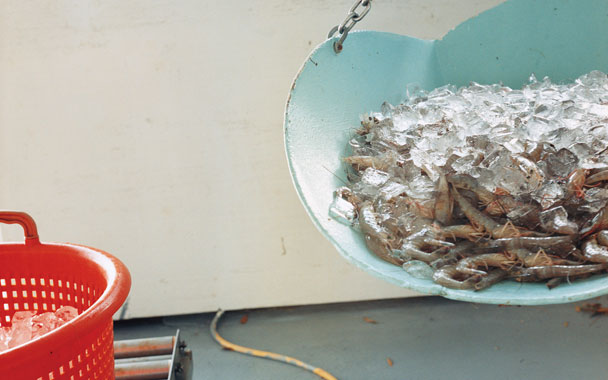We are a couple of miles off the South Carolina coast, and Captain Kerry Abraham is dangling from an outrigger 50 feet beyond the starboard gunwale of the Miss Kathy. For ten minutes, he has been trying to disentangle a braided steel cable as thick as my thumb and so taut the wind whistles through it. With its massive metal beams, gears, chains, and levers, a shrimp trawler is like a piece of heavy construction equipment, except that it also rocks, sways, heaves, and lurches. Abraham is about to be dunked into the turbid ocean. Then the 78-foot-long ship rolls and catapults him almost vertically overhead. Not for the first time, it strikes me that it helps to be a little bit crazy if you are a commercial shrimp fisherman.
When I boarded the Miss Kathy one morning last August, it was my final stop on a quest that had been far more difficult than I had expected: I wanted to find a shrimp that I could eat with both gusto and good conscience. Bright orange, glistening, and hooked over the rim of a cocktail glass, shrimp were my first “luxury” food. But sometime in the mid-1980s, just as our love affair was settling into a steady relationship, shrimp jilted me. A bag from the local supermarket was fine one week, and reeked of ammonia the next, with a peculiar muddy aftertaste.
Today, the average American eats four pounds of shrimp per year, double what we ate in the 1990s. This is at least in part because these little crustaceans are cheaper and more plentiful than ever before. Supermarket freezer cases overflow with bags from Mexico, Ecuador, China, India, Thailand, Vietnam, and Bangladesh. But the vast majority of the shrimp we eat today are no longer wild and netted from unpolluted ocean waters by men like Kerry Abraham. Instead, they’re grown in crowded, murky, man-made ponds in developing countries—which may go a long way toward explaining why they often taste like bottom-feeding farmed fish.
By the time I noticed this change in flavor, the industry had grown into one of the most destructive means by which humans produce food. Shrimp farmers started by clear-cutting vast coastal fringes of mangroves—crucial breeding grounds for fish—to create ponds. As rotting shrimp carcasses and uneaten shrimp food polluted estuaries and bays, farmers hacked down more trees and built more ponds. Captive shrimp eat animal protein, and back then as many as four pounds of fish were needed to produce a single pound of shrimp, and that didn’t count the loss of aquatic life from pollution and habitat destruction. Jason Clay, a vice president of the World Wildlife Fund, succinctly summed up the problem with this type of aquaculture: “Fish are the only carnivores consumed in any quantity by people.”
Captive shrimp are notoriously susceptible to viral and bacterial epidemics, and in response, farmers have deployed an arsenal of more than 20 antibiotics and pesticides. Chloramphenicol, a potent antibiotic banned for use in animals in the United States in 1986, became the drug of choice in parts of Asia, even though humans exposed to minuscule quantities can suffer the fatal blood disease aplastic anemia, among other adverse affects. There is no known level at which chloramphenicol is safe. Because of all these problems, Seafood Watch, a program of the Monterey Bay Aquarium that monitors fisheries for sustainability, puts foreign-farmed shrimp in its “Avoid” category. The better choice, according to the group, is American wild shrimp.
But Kerry Abraham and the 13,000 other Americans who earn a living from wild shrimp are having trouble making ends meet. In 2004, the Commerce Department accused China, Vietnam, Thailand, India, Brazil, and Ecuador of dumping cheap shrimp into the United States and imposed tariffs on them. Still, foreign production continued to surge, and the tariffs failed to stem the price free fall. Between 2000 and 2005, the average price South Carolina shrimpers received for their catches dropped from nearly $4 a pound to just $2.59. “I’ll be able to hold on because I have my own dock and freezers and sell directly to my customers,” said Abraham, who at the age of 52 has no intention of changing careers. “I’ve been shrimping since I was eight. Bought my first boat at seventeen. It’s all I know.”
For the moment, he has solved the more immediate problem. With a loud thwack, the hung-up cable springs free, and the net fans out in the Miss Kathy’s wake, forming an opening 100 feet across before disappearing beneath the milky brown water. The next two hours pass tranquilly. Abraham sits behind the wheel in the pilot house and steers a straight, slow course. Joseph Aiken, one of his hands, fries up eggs and sausage in the galley. James Stanley Golden, the other crewman, snoozes in his bunk. On deck, the day is clear and hot. Porpoises surf on our bow wave. Gulls and pelicans perch on every available inch of rigging, wearing expectant looks. The quiet grumble of the engines is the only thing breaking the silence.
Suddenly, all hell breaks loose. On the back deck, Aiken and Golden tug lines and activate winches, skip-roping over chains and cables. The net is cranked in on rollers the size of tractor tires. A slimy avalanche of what looks like formless aquatic protoplasm spews onto a counter-height platform near the stern. Jellyfish predominate, but there are also crabs, rays, starfish, immature sharks, spadefish, flounder, silver eels, mackerel, and whiting. With rapid, practiced movements, Aiken and Golden sink their hands into the mass and pluck out shrimp, tossing them into bushel-size plastic baskets, which fill in a matter of minutes. The rest of the net’s contents—mostly dead—they scrape over the stern, much to the delight of the screeching and diving seabirds.




 Pinterest
Pinterest






